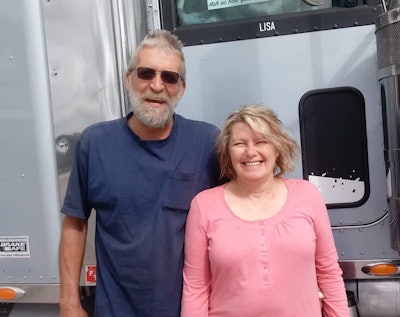
Much has been made through the years about the constraints of a one-size-fits-all approach to the hours of service regulations. While there are in fact many variations in rules depending on the nature of the trucking operation (oil-field, ag, short-haul ...), the reality that there is no recognition of proven safety in the rules for longer-run interstate property carriers has been a topic of discussion for decades. Some veteran owners have in past argued for additional hours flexibility for such proven, safe operators, and back in June, one owner put forward an exemption request that in some ways tracks closely to that idea.
Leland (Lee) Schmitt and his wife and business partner, Lisa, petitioned the Federal Motor Carrier Safety Administration for an exemption from most of the hours of service regulations based on Lee’s safe driving record and experience.
Schmitt asked FMCSA for exemption from the requirement to take a 10-hour break, from the 14-hour daily duty maximum and from the cumulative 60 in 7 days and/or 70 in 8 days duty limitations. He did not, however, ask for exemption from the 11-hour maximum daily drive time limit.
In his request, he said the mandatory 10-hour off-duty break “goes against his natural sleep patterns, as his normal nighttime sleep while in the CMV is between five to seven hours.”

The docket was open to public comments for 30 days and received more than 650 comments -- some in support of the operator’s request and some against.
Owner-operator Lindsay Scott-Funk summed up the feeling of many in favor of such an exemption, saying “this should really be a common-sense exemption for anyone that wants one. To try and force all drivers to work at the same time is just asking for trouble.”
Scott-Funk added that drivers “should have the ability to tailor their workday to the way they want to work.”
[Related: Owner-operator asks FMCSA for exemption from HOS]
David Michaels, a former owner-operator and small fleet owner and current transportation and logistics consultant, was also in favor of granting the exemption, not just for Schmitt -- “for the industry as a whole. For once listen and take action using the experience of the one actually doing the work.”
Elizabeth Williams said she believed that “any driver that demonstrates proficiency through an extensive history of 10 or more years within this industry" should be similarly exempt.
She added that drivers with clear MVRs with no accidents have proven that they can do their jobs safely.
“Many of us have said for decades that our sleep patterns do not hold with the patterns of the hours of service,” Williams said. “Me personally, I might get 4-5 hours of continuous sleep and am then wide awake and forced to stand idle while waiting for an arbitrary clock to reset, even though I am alert and completely able to do my job.”
Mike Landis, owner-operator of Landis & Sons Trucking, agreed that Schmitt’s request should be granted, noting that bound by the 11-hour daily maximum, “it is obvious he is not trying to work more, but only as he feels fit to do so.”
Landis added that with traffic, detention and more that drivers deal with, “it only makes sense.”
Endorsing a skeptical view of a one-size-fits-all hours regs approach, Landis felt that in the case of a safe operator who has "proven to be responsible, I don't see any reason that one shouldn't be able to perform their tasks as they please.”
[Related: What if you didn't need 10 after 11 or 14 in the hours of service? This owner aims to find out]
Safety and crash-victims-advocacy groups Advocates for Highway and Auto Safety and the Truck Safety Coalition, commenting together, were against the Schmitts' exemption request. Granting it, they said, “would be utterly reckless and presents a needless threat to public safety regardless of his past driving record.
“Granting the application would also disregard well established science on driver fatigue,” the groups added. “Numerous researchers have stressed that long consecutive driving hours, long duty weeks, and inadequate and interrupted sleep are directly related to increased crash risks. In fact, many researchers, as well as the FMCSA, have shown that the risk of having a crash rapidly escalates after the eighth or ninth consecutive hour of driving.”
Mike Millard, president and Chief Safety Officer of transportation consulting firm AWM Associates, endorsed the view that the hours limits are beneficial to safety, noting that the hours of service rules, particularly the 11- and 14-hour limits and the 10-hour break in effect for well more than a decade now, may have contributed to Schmitt’s exemplary driving record. “Since Mr. Schmitt's safe driving hasn't been impacted since 2011, the current HOS are suitable and have contributed to Mr. Schmitt's success as a safe driver, regardless of his perceptions on the matter,” Millard said.
He added that if FMCSA grants Schmitt’s petition, “FMCSA would be flooded by hundreds of thousands of requests from drivers wanting to be party to the exception.” At once, Milliard endorsed a re-examination of the current rules. FMCSA should “consider a maximum of 12 hours driving with a mandated 30-minute break in 15 continuous [duty] hours and a nine-hour break to reset the 12/15-hour clocks. The added hours of operation would help America's supply chain issues and contribute to effectiveness of drivers/trucks.”
Trucking veteran Bob Stanton, who works with truck drivers dealing with sleep apnea, said that despite Schmitt’s claim that he can recognize when his body needs rest and when he can safely drive, “sleep research on fatigue has regularly shown little or no correlation between a test subject’s perceived levels of fatigue and the results of objective testing.”
[Related: This brain trick worsens the danger of cumulative sleep loss]
Stanton added that Schmitt does not provide enough evidence to prove his 30 years of safe driving experience or to show his sleep patterns. He suggested that Schmitt should be required to publish all inspection and crash data shown in the Motor Carrier Management Information System, as well as all information “available through public driver employment history services such as DAC to capture accidents and incidents which did not rise to the level of a DOT reportable accident to be in MCMIS.”
In response, Schmitt uploaded to the docket supporting documents, including his MVR from his home state of Wisconsin and his PSP report from FMCSA. He also included an example of a log for a trip from Wisconsin to Phoenix that he makes often, with one log showing his trip using the current HOS rules, and another showing an example of how he would operate if granted the exemption. In both cases, the trip took four days.
Gaming out running under the exemption, Schmitt would be "able to stop, and eat and rest during the day, also avoiding rush hour traffic," he said. "This increases safety in two ways. Rest for the driver, and less traffic on the roads when we travel."
Regarding the sleep issues Schmitt mentions in his request, Stanton said Schmitt should be required to submit to a series of so-called "Maintenance of Wakefulness" tests that measure daily wakefulness.
Schmitt commented with general responses to other commentary in the docket, too. He noted one challenge of writing the exemption request was “to show how to maintain a level of safety equivalent to, or greater than, the level achieved without the exemption. Without having a stated ‘level of safety’ under the current regulations, it is difficult to show how to meet or exceed that ‘level.’”
In response to commenters like Millard, who said the HOS may have contributed to his safe driving record, Schmitt noted his safe driving record “has been maintained through years of being on paper logs, when we all know the HOS looked good on paper but were not necessarily followed in real life."
Schmitt added he’s aware that the 10-hour break does not require 10 hours of sleep, but noted the he “would be able to achieve a sufficient amount of rest by breaking up my total sleep periods throughout a 24 hour day.”
Schmitt also agreed that, based on the comments his petition received, granting his exemption might “create a flood of requests” from other operators to FMCSA. “Perhaps the data generated by granting my request would be a start of a pilot program of experienced, safe drivers to determine if the HOS needs to be revisited in the future, or if a tiered program could benefit the industry and retain these experienced, safe drivers to benefit the supply chain.”
[Related: Another trucker seeks exemption from hours of service regs]










